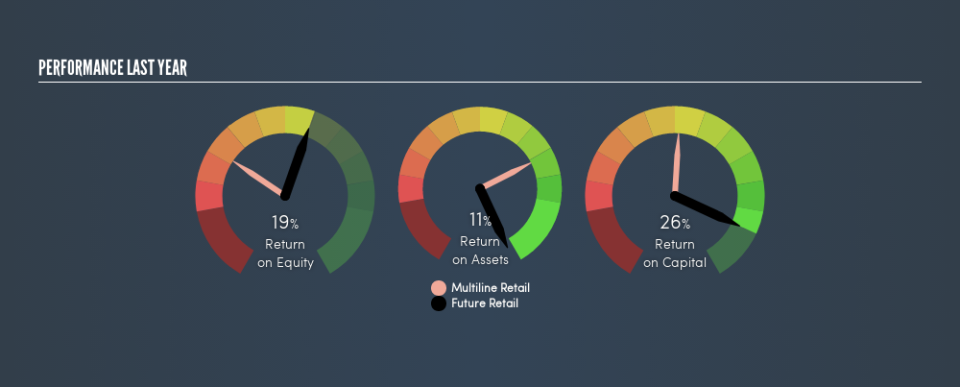Here's What Future Retail Limited's (NSE:FRETAIL) ROCE Can Tell Us

Today we'll evaluate Future Retail Limited (NSE:FRETAIL) to determine whether it could have potential as an investment idea. Specifically, we're going to calculate its Return On Capital Employed (ROCE), in the hopes of getting some insight into the business.
First of all, we'll work out how to calculate ROCE. Next, we'll compare it to others in its industry. Finally, we'll look at how its current liabilities affect its ROCE.
Return On Capital Employed (ROCE): What is it?
ROCE is a measure of a company's yearly pre-tax profit (its return), relative to the capital employed in the business. In general, businesses with a higher ROCE are usually better quality. Ultimately, it is a useful but imperfect metric. Author Edwin Whiting says to be careful when comparing the ROCE of different businesses, since 'No two businesses are exactly alike.'
How Do You Calculate Return On Capital Employed?
Analysts use this formula to calculate return on capital employed:
Return on Capital Employed = Earnings Before Interest and Tax (EBIT) ÷ (Total Assets - Current Liabilities)
Or for Future Retail:
0.26 = ₹11b ÷ (₹106b - ₹62b) (Based on the trailing twelve months to June 2019.)
So, Future Retail has an ROCE of 26%.
See our latest analysis for Future Retail
Does Future Retail Have A Good ROCE?
When making comparisons between similar businesses, investors may find ROCE useful. In our analysis, Future Retail's ROCE is meaningfully higher than the 20% average in the Multiline Retail industry. We would consider this a positive, as it suggests it is using capital more effectively than other similar companies. Putting aside its position relative to its industry for now, in absolute terms, Future Retail's ROCE is currently very good.
In our analysis, Future Retail's ROCE appears to be 26%, compared to 3 years ago, when its ROCE was 12%. This makes us think about whether the company has been reinvesting shrewdly. The image below shows how Future Retail's ROCE compares to its industry, and you can click it to see more detail on its past growth.
When considering this metric, keep in mind that it is backwards looking, and not necessarily predictive. ROCE can be deceptive for cyclical businesses, as returns can look incredible in boom times, and terribly low in downturns. ROCE is, after all, simply a snap shot of a single year. What happens in the future is pretty important for investors, so we have prepared a free report on analyst forecasts for Future Retail.
How Future Retail's Current Liabilities Impact Its ROCE
Short term (or current) liabilities, are things like supplier invoices, overdrafts, or tax bills that need to be paid within 12 months. Due to the way the ROCE equation works, having large bills due in the near term can make it look as though a company has less capital employed, and thus a higher ROCE than usual. To counteract this, we check if a company has high current liabilities, relative to its total assets.
Future Retail has total liabilities of ₹62b and total assets of ₹106b. Therefore its current liabilities are equivalent to approximately 58% of its total assets. While a high level of current liabilities boosts its ROCE, Future Retail's returns are still very good.
Our Take On Future Retail's ROCE
So we would be interested in doing more research here -- there may be an opportunity! There might be better investments than Future Retail out there, but you will have to work hard to find them . These promising businesses with rapidly growing earnings might be right up your alley.
I will like Future Retail better if I see some big insider buys. While we wait, check out this free list of growing companies with considerable, recent, insider buying.
We aim to bring you long-term focused research analysis driven by fundamental data. Note that our analysis may not factor in the latest price-sensitive company announcements or qualitative material.
If you spot an error that warrants correction, please contact the editor at editorial-team@simplywallst.com. This article by Simply Wall St is general in nature. It does not constitute a recommendation to buy or sell any stock, and does not take account of your objectives, or your financial situation. Simply Wall St has no position in the stocks mentioned. Thank you for reading.

